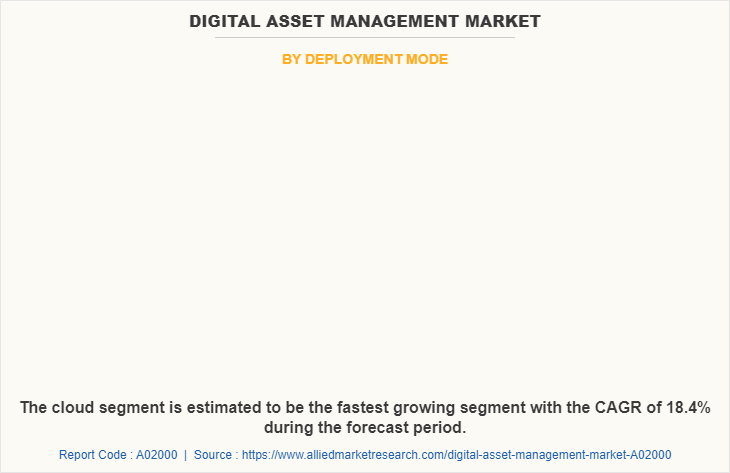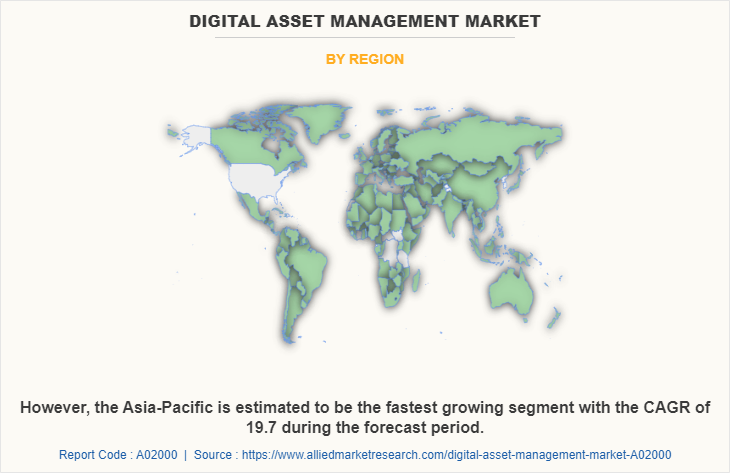Digital Asset Management Market Size & Insights:
The global digital asset management market was valued at USD 4.9 billion in 2022, and is projected to reach USD 20.6 billion by 2032, growing at a CAGR of 15.8% from 2023 to 2032.
Factors such as the rise in the need for collaborative digital workflow, especially for marketing activities, encouraged organizations to use advanced digital asset management solutions. In addition, growth in the need to meet the government’s compliance is anticipated to accelerate the market growth. Moreover, increasing adoption of cloud-based DAM solutions, growth in e-commerce and digital marketing and rising demand for video content are also propel the growth of the market.
Furthermore, expansion of AI and machine learning capabilities in DAM and growing importance of data analytics and insights for digital asset management, are expected to drive the growth of the digital asset management market during the forecast period. However, high initial investments, concerns over data security, privacy, & compliance with regulations and the lack of a skilled workforce are some of the factors that are anticipated to hinder market growth. In addition, the need for ongoing maintenance and updating of the DAM system and challenges associated with managing and storing large volumes of digital assets are expected to hamper the growth of the market.
Digital asset management (DAM) is the practice of organizing, storing, cataloging, retrieving, and distributing digital assets, such as images, videos, documents, and other multimedia content. DAM systems typically provide tools for managing the lifecycle of digital assets, including creation, versioning, approval, and distribution. The primary goal of DAM is to provide a centralized repository for digital assets that enables teams to easily locate and access the assets they need, and to ensure that the assets are used appropriately and consistently across different channels and platforms.
Furthermore, DAM can also help improve collaboration, workflow efficiency, and asset reuse, while reducing costs associated with asset duplication and redundant storage. DAM systems can be used by a variety of organizations, from small businesses to large enterprises, and can be customized to meet the specific needs of different industries, including marketing, media and entertainment, education, government, and others.
Furthermore, the emergence of new business models, such as subscription-based pricing, make DAM more accessible to smaller organizations. Such a trend is expected to provide lucrative opportunities for the market growth in the future. Additionally, expansion of DAM solutions into new sectors, such as healthcare and education and development of new technologies, including virtual and augmented reality (AR), require efficient management of digital assets. Such factors are expected to provide lucrative growth opportunities for the DAM market during the forecast period. Moreover, increasing importance of digital assets for businesses of all sizes is providing opportunities for DAM vendors to expand their customer base.
The digital asset management market is segmented into offering, business function, deployment mode and region. By offering, it is bifurcated into solution and services. By deployment mode, it is divided into on-premises and cloud. By business function, the market is segregated into human resources (HR), sales & marketing, information technology (IT) and others. Region wise, it is analyzed across North America, Europe, Asia-Pacific, and LAMEA.
On the basis of deployment mode, the on-premise segment captured the largest digital asset management market share in 2022 and is expected to continue this trend throughout the forecast period. This is attributed to the numerous advantages offered by the on-premise deployment such as a high level of data security and safety. Industries prefer on-premise mode owing to high data security and less data breaches as compared to cloud based deployment models, which further drives the demand for on-premise deployment models within the sectors. However, the cloud segment is expected to exhibit highest digital asset management market growth during the forecast period.

Factors such as the rise in the adoption of cloud-based digital asset management due to low cost and easier maintenance drive the growth of the market. In addition, it provides flexibility & scalability to boost business processes, which propels the growth of the digital asset management market trends.
By region, North America dominated the market share in 2022 for the digital asset management market. The increase in usage of digital asset management solutions in businesses to improve businesses and the customer experience are anticipated to provide lucrative growth opportunities for the market in North America. However, Asia-Pacific is expected to exhibit the highest growth during the forecast period. This is attributed to the increase in penetration of advanced technology and higher adoption of cloud-based solutions and services, which propel the growth of the digital asset management market in this region.

Top Impacting Factors:
Increase in Adoption of Cloud-based DAM Solutions
One of the key drivers for the digital asset management industry is the increasing adoption of cloud-based DAM solutions. Cloud-based DAM solutions offer many benefits over traditional on-premise solutions, including scalability, flexibility, and accessibility. With cloud-based DAM, organizations can store and manage their digital assets in a secure, centralized location that can be accessed from anywhere, at any time. This makes it easier for teams to collaborate and share assets, regardless of their location or device.
Moreover, cloud-based DAM solutions also offer greater scalability, allowing organizations to easily expand their storage capacity as their digital asset library grows. This can help organizations avoid the high upfront costs associated with traditional on-premise solutions, which require significant investments in hardware and infrastructure.
In addition, cloud-based DAM solutions are highly flexible, offering a range of customization options to meet the specific needs of different industries and organizations. They also offer advanced features, such as AI and machine learning capabilities, that can help organizations automate many of the tasks associated with managing digital assets, such as tagging and categorizing.
Further, the increasing adoption of cloud-based DAM solutions is driving growth and innovation in the digital asset management industry and providing organizations with new opportunities to improve their workflows and optimize the use of their digital assets.
Expansion of AI and Machine Learning Capabilities in DAM
The expansion of artificial intelligence (AI) and machine learning capabilities in digital asset management (DAM) represents a major driver for the industry. AI and machine learning have the potential to transform how organizations manage their digital content, by automating many of the tasks associated with asset creation, management, and distribution. One of the key benefits of AI and machine learning in DAM is the ability to automatically categorize and tag assets based on their content. This can save organizations significant time and resources, by eliminating the need for manual tagging and categorization. In addition, AI and machine learning can help organizations identify duplicate or similar assets and suggest alternative or related assets to use instead.
AI and machine learning can also be used to automate the process of converting assets into different formats and sizes, making it easier for organizations to distribute their content across multiple channels and devices. This can help improve the reach and effectiveness of their marketing and communication efforts, by ensuring that content is optimized for each platform and audience. Another area where AI and machine learning can have a significant impact is in the analysis of asset performance and engagement. By tracking user behavior and engagement metrics, DAM solutions can use AI and machine learning algorithms to identify patterns and insights that can help organizations optimize their content and improve their marketing and communication strategies.
As a result, the expansion of AI and machine learning capabilities in DAM is being driven by several factors, including the growing volume and complexity of digital content, the need for greater efficiency and automation, and the increasing demand for personalized and engaging content. As DAM vendors continue to invest in AI and machine learning technologies, they can expect to see continued growth in this area and leverage the benefits of DAM to improve their content management and distribution processes.
Key Benefits for Stakeholders
- The study provides an in-depth digital asset management market analysis along with the current trends and future estimations to elucidate the imminent investment pockets.
- Information about key drivers, restraints, and opportunities and their impact analysis on the digital asset management market size is provided in the report.
- The Porter’s five forces analysis illustrates the potency of buyers and suppliers operating in the Digital asset management industry.
- The quantitative analysis of the global sports management market for the period 2022–2032 is provided to determine the digital asset management market potential.
Digital Asset Management Market Report Highlights
| Aspects | Details |
| Market Size By 2032 | USD 20.6 billion |
| Growth Rate | CAGR of 15.8% |
| Forecast period | 2022 - 2032 |
| Report Pages | 363 |
| By Offering |
|
| By Deployment Mode |
|
| By Business Function |
|
| By Region |
|
| Key Market Players | Dell EMC, North Plains Systems (Ignite Enterprise Software Solutions, Inc.), IBM CORPORATION, Open Text Corporation., Adobe Inc., Aprimo, Oracle Corporation, Hewlett Packard Enterprise (HPE), Widen Enterprises Inc., Cognizant Technology Solutions Corporation |
Analyst Review
Digital asset management refers to a system or software that allows organizations to store, organize, retrieve, and distribute digital assets in a centralized and structured manner. It provides tools and functionalities for managing various types of digital content, such as images, videos, audio files, documents, and graphics. These systems typically include features like metadata tagging, version control, rights management, and workflow automation, enabling efficient asset management throughout the lifecycle.
Key providers in the digital asset management market are Adobe Systems, Inc., Cognizant Technology Solution Corp., and Dell EMC. With the growth in demand for digital asset management services, various companies have established partnerships to increase their solutions offerings in digital solutions. For instance, in January 2023, NICE partnered with Cognizant. to leverages Cognizant’s deep consulting and business transformation capabilities along with NICE CXone’s industry-leading complete, integrated cloud platform to accelerate customer adoption of advanced CX solutions such as digital, analytics, and conversational AI. Thus, further drives the market growth.
In addition, with the surge in demand for digital asset management, various companies have expanded their current product portfolio to continue with the rising demand in the market. For instance, in April 2021, Adobe launched a new asset management tool namely, Adobe Experience Manager Assets Essentials. To provide teams that work with a number of digital assets an easier-to-use management experience in the Adobe Experience Cloud than Adobe’s current enterprise-centric asset management tool can offer.
For instance, in March 2022, HPE partnered with Digital Realty, to deliver the cloud experience with colocation. The colocation solves the challenges of global coverage and capacity and to gain proximity to centers of data exchange and digital ecosystems. This strategic partnership is expected to drive market growth.
Global Digital Asset Management Market is Expected to Reach $ 20,600.90 Million by 2032.
The North America is the largest market for the Digital Asset Management
Factors such as the rise in the need for collaborative digital workflow, especially for marketing activities, encouraged organizations to use advanced digital asset management solutions.
The key growth strategies for Digital Asset Management include product portfolio expansion, acquisition, partnership, merger, collaboration and others
Adobe Inc., Cognizant Technology Solutions Corporation, Dell EMC, Hewlett Packard Enterprise (HPE), IBM Corporation, Oracle Corporation, OpenText Corporation, Widen Enterprises Inc. and others
Loading Table Of Content...
Loading Research Methodology...



